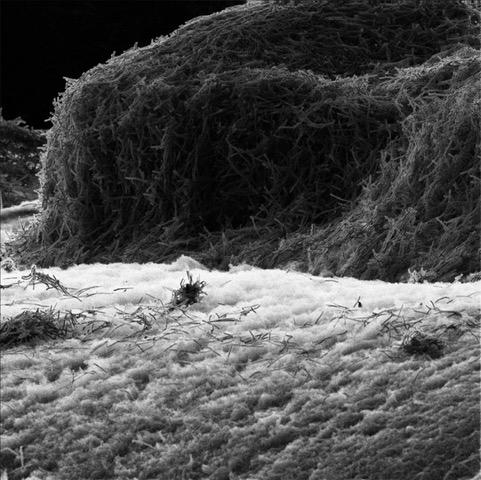Bacteria-infecting viruses bind mucosal surface and protect from disease

Helium ion microscope image of bacterial growth. Credit: Gabriel Almeida/University of Jyväskylä
The mucosal surfaces are important for protection of tissues and homeostasis, but often targeted by disease-causing bacteria. Phages have been suggested to specifically bind to host mucosal surfaces and prevent colonization by pathogenic bacteria.
In this symbiotic model phage populations are enriched in the mucus, a substrate in which encounters with their bacterial hosts are more probable, while the animal benefits from protection against invading bacteria.
Researchers at the University of Jyväskylä tested this idea using rainbow trout, phages (viruses) and a fish-infecting bacterium (Flavobacterium columnare). Phages were found to bind to fish mucosa, and maintain there for several days.
Phages bound in mucus also protected the fish from diseases, although the pathogenic bacteria had a strong chemotaxis towards mucus, and exposure to mucosal molecules made them more virulent.
However, the mucosal environment made the bacteria more susceptible for phage infections, revealing a new aspect of the tripartite interactions between mucosal surfaces, bacteria and phages.
In conclusion, the mucosal environment influence both bacteria and phages. These interactions are important for understanding disease ecology and has significant impact in preventive phage therapy approaches.
###
The research has been published in mBio: https:/
For further information:
Postdoctoral researcher Gabriel Almeida, gabriel.m.almeida@jyu.f
Communications officer, Tanja Heikkinen, tanja.s.heikkinen@jyu.fi, tel. 050 581 8351
Nanoscience Center at University of Jyväskylä: https:/
Facebook: jyuscience Twitter: jyscience Instagram: jyscience
Media Contact
All latest news from the category: Life Sciences and Chemistry
Articles and reports from the Life Sciences and chemistry area deal with applied and basic research into modern biology, chemistry and human medicine.
Valuable information can be found on a range of life sciences fields including bacteriology, biochemistry, bionics, bioinformatics, biophysics, biotechnology, genetics, geobotany, human biology, marine biology, microbiology, molecular biology, cellular biology, zoology, bioinorganic chemistry, microchemistry and environmental chemistry.
Newest articles

“Nanostitches” enable lighter and tougher composite materials
In research that may lead to next-generation airplanes and spacecraft, MIT engineers used carbon nanotubes to prevent cracking in multilayered composites. To save on fuel and reduce aircraft emissions, engineers…

Trash to treasure
Researchers turn metal waste into catalyst for hydrogen. Scientists have found a way to transform metal waste into a highly efficient catalyst to make hydrogen from water, a discovery that…

Real-time detection of infectious disease viruses
… by searching for molecular fingerprinting. A research team consisting of Professor Kyoung-Duck Park and Taeyoung Moon and Huitae Joo, PhD candidates, from the Department of Physics at Pohang University…





















